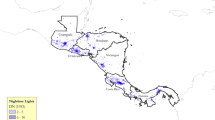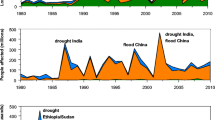Abstract
In the past decades, natural disasters have caused substantial human and economic losses in Central America, with strong adverse impacts on gross domestic product per capita, income, and poverty reduction. This study provides a regional perspective on the short-term impact of hurricane windstorms on socioeconomic indicators. Apart from modeling the socioeconomic impact at the macro and micro levels, the study incorporates and juxtaposes data from a hurricane windstorm model categorizing three hurricane damage indexes, which lends a higher level of detail, nuance, and therefore accuracy and comprehensiveness to the study. One standard deviation in the intensity of a hurricane windstorm leads to a decrease in growth of total per capita gross domestic product of between 0.9 and 1.6%, and a decrease in total income and labor income by 3%, which in turn increases moderate and extreme poverty by 1.5 percentage points. These results demonstrate the causal relationship between hurricane windstorm impacts and poverty in Central America, producing regional evidence that could improve targeting of disaster risk management policies toward those most impacted and thus whose needs are greatest.


Similar content being viewed by others
Notes
Calculation of authors based on information from EM-DAT: the international Disasters Database.
Dell et al. (2014) provide an excellent review on the new climate-economy literature and summarize results on different socioeconomic outcomes (e.g., health, conflict, economic growth, among others).
This research has been funded by the World Bank through a Global Facility for Disaster Reduction and Recovery (GFDRR) grant (TF014499) from the Government of Australia (AusAid) under the CAPRA Probabilistic Risk Assessment program (P144982).
Another aspect that needs to be addressed in the characterization of hurricanes is the temporal and spatial mismatch between socioeconomic data and wind speed data. Socioeconomic data are often collected, calculated or released at an aggregate level by country or region on a yearly basis. Meanwhile, wind speed data are available at a finer resolution (1 km2) for each point in time. In the case of the GDP analysis (Sect. 3), indexes are aggregated at the country level, while in the case of the household analysis (Sect. 4), indexes are aggregated at the sub-national level (regions).
We use the GHSL—Global Human Settlement Layer Population dataset for available years (1975, 1990, 2000, and 2015). We make sure to use pre-shock population to avoid endogeneity bias.
However, this scenario is unlikely to be the case, since people not only have to recognize the low-hazard areas, but also they have to recognize the distribution of areas by hazard. In other words, they need to identify the ranking of areas by from low to high hazard. This assumption is rather difficult to hold in practice.
Strobl (2012) suggests that this parameter relates local wind speed to the local level of damages: “We regressed the log of the normalized cost values calculated by Pielke et al. (2008) who normalized hurricane damages with regard to changes in inflation, population, and wealth of only the counties affected on the log of maximum observed wind speeds of the hurricanes in Nordhaus' data set, and found that the resultant coefficient implies that costs rise to the 3.8th”.
Each additional unit of wind speed does not cause a constant level of damage.
The National Hurricane Center provides further explanation and a conceptual animation of the SS categories: http://www.nhc.noaa.gov/aboutsshws.php.
Related categories are tropical storm (63–118 km/h) and tropical depression (≤ 62 km/h).
For example, according to SEDLAC, the share of dwellings of low-quality materials in Central America could be high as in Guatemala (46%), El Salvador (31%), Nicaragua (15%), and Honduras (14%).
SEDALAC: Socio-Economic Database for Latin America and the Caribbean (Universidad Nacional de La Plata/World Bank). Please refer to Sect. 4 for further details on the regions considered at the household level analysis.
Results available upon request.
Nicaragua: Joan (1998), Cesar (1996), Felix (2007). Honduras: Mitch (1998).
See Appendix Table 7 for storm’s details. It includes the value for each hurricane index and the number of casualties and damages from NOAA.
For example, the IHD index (population-weighted wind speed) powers wind speed to the 3.8, hence unstandardized coefficients are simply smaller than the MSWS and WEI indexes.
Column (1), without controlling for serial and spatial correlation, only shows significant results for IHD but not for the other two indices (MSWS and WEI). When correcting, Column (2) results consistent negative and significant estimates.
Its WEI was 30.41 and its IDH was 699,548.
Due to this reason and the lack of power, we hypothesize that results for column (2) in Table 3 are not significant (MSWS and WEI).
Results available upon request.
Tables 9, 10, 11 in “Appendix” show the full set of results including for the control variables. In the case of Central America, these control variables are not significant nor affect our regression estimates. However, we include them aiming to replicate clearly Strobl’s results and compare the index of hurricane destruction (IHD) with the other proposed indexes.
For further details, please refer to the World Bank’s Equity Lab website: http://globalpractices.worldbank.org/teamsites/Poverty/LACDataLab/Pages/TeamHome.aspx.
We use income data at the household level, rather than consumption, due to its availability. It is the only related-variable comparable across survey and country.
The ratio of members of the household to the number of exclusive rooms occupied by the household.
Households are considered to have unsatisfied basic needs in subsistence capacity based on two conditions: (1) the ratio of members of the household to the employed members is higher than 3; and (2) the household head has at most elementary school education.
Where the construction materials of the dwelling are of low quality.
See Appendix Table 8 for storm’s details.
Notice that Hurricane Beta discussed in the second section of the paper is not considered in the analysis because it was a tropical storm when hit Nicaragua.
Results shown in the paper exclude Panama because Panama’s observable household characteristics are not available. However, results including Panama and without controlling for observable characteristics show similar qualitative results. Results available upon request.
Hurricane Matthew landed in Honduras in 2010 with an SS scale of 2 in the Socio-Economic Region 5 with a Maximum Sustained Wind Speed of 97.92 mph and with and SS scale of 1 in the Socio-Economic Region 2. Hurricane Matthew landed also in Guatemala with a SS scale of 1 in outside the Metropolitan Region with a Maximum Sustained Wind Speed of 81.64 mph.
As defined in each household survey per country.
References
Anttila-Hughes J, Hsiang S (2014) Destruction, disinvestment, and death: economic and human losses following environmental disaster. Available at SSRN: http://ssrn.com/abstract=2220501. Accessed 12 Dec 2015
Baez J, Santos I (2007) Children’s vulnerability to weather shocks: a natural disaster as a natural experiment. http://citeseerx.ist.psu.edu/viewdoc/download;jsessionid=D3E4D0D9B5A87E66A235C91E2695017D?doi=10.1.1.175.2774&rep=rep1&type=pdf. Accessed 12 Dec 2015
Baez J, Lucchetti L, Genoni M, Salazar M (2017) Gone with the storm: rainfall shocks and household well-being in guatemala. J Dev Stud 53(8):1253–1271
Bruno GSF (2005) Approximating the bias of the LSDV estimator for dynamic unbalanced panel data models. Econ Lett 87:361–366
Bustelo M (2011) Bearing the burden of natural disasters: child labor and schooling in the aftermath of the tropical storm stan in Guatemala. Doctoral dissertation. Retrieved from the University of Illinois at Urbana-Champaign
Carter M, Little P, Mogues T, Negatu W (2007) Poverty traps and natural disasters in Ethiopia and Honduras. World Dev 35(5):835–856
CEPAL (2011) Resumen regional del impacto de la depresión tropical 12-E en Centroamérica. Cuantificación de daños y pérdidas sufridos por los países de la región en el mes de octubre de 2011. http://www.cepal.org/publicaciones/xml/3/46593/2012-012-Depresi%C3%B3n_Tropical-12-E.L.1060-Parte_1.pdf. Accessed 12 Dec 2015
Conley TG (2008) Spatial Econometrics. In: Durlauf SN, Blume LE (eds) The New Palgrave dictionary of economics, vol 7, 2nd edn. Palgrave Macmillan, Houndsmills, pp 741–747
Dell M, Jones B, Olken B (2014) What do we learn from the weather? The new climate-economy literature. J Econ Lit 52(3):740–798
Dercon S (2005a) Vulnerability: a micro perspective. QEH Working Papers 149, Queen Elizabeth House, University of Oxford
Dercon S (2005b) Vulnerability: a micro perspective. Paper presented at the ABCDE Europe conference, Amsterdam, May 2005
Hsiang SM (2010) Temperatures and cyclones strongly associated with economic production in the Caribbean and Central America. Proc Natl Acad Sci 107(35):15367–15372
Hsiang SM, Jina A (2013) The causal effect of environmental catastrophe on long-run economic growth. Unpublished
Hsiang SM, Jina A (2014) The causal effect of environmental catastrophe on long-run economic growth: evidence from 6700 cyclones. NBER Working Paper 20352
Krozer A (2010) A regional basic income: towards the eradication of extreme poverty in Central America. ECLACL Working Paper LC/MEX/L.998
Lucchetti L (2011) Three essays on household welfare. Doctoral dissertation. Retrieved from University of Illinois at Urbana Champaign
Noy I (2009) The macroeconomic consequences of disasters. J Dev Econ 88:221–231
Pielke R, Gratz J, Landsea C, Collings D (2008) Normalized hurricane damages in the United States: 1900–2005. Nat Hazards Rev 29:29–42
Pita G, Gunasekera R, Ishizawa O (2015) Windstorm hazard model for disaster risk assessment in Central America. Working Paper
Raddatz C (2009) The wrath of god macroeconomic costs of natural disasters. Policy Research Working Papers, No. 5039, World Bank, Washington, DC
Rodriguez-Oreggia E, De la Fuente A, De la Torre R, Moreno H (2013) Natural disasters, human development and poverty at the municipal level in Mexico. J Dev Stud 49:442–455
Strobl E (2012) The economic growth impact of natural disasters in developing countries: evidence from Hurricane strikes in the Central American and Caribbean Regions. J Dev Econ 97:130–141
Thomas T, Christiaensen L, Do Q, Trung L (2010) Natural disasters and household welfare: evidence from Vietnam. Policy Research Working Papers, No. 5491, World Bank, Washington, DC
Vickery PJ, Skerlj PF (2005) Hurricane gust factors revisited. J Struct Eng 131:825–832
World Bank (2015) LAC Equity Lab. http://www.worldbank.org/en/topic/poverty/lac-equity-lab1/overview. Accessed 12 Dec 2015
Author information
Authors and Affiliations
Corresponding author
Additional information
This work was funded by The World Bank’s Global Facility for Disaster Reduction and Recovery Program (Trust Fund # TF018258). We thank Eric Strobl and Stephane Hallegatte for helpful comments and suggestions. We also thank two anonymous reviewers for helpful comments on earlier drafts of the manuscript. Johanan Rivera Fuentes for the overall coordination and for drafting the first version of this paper; Luis Felipe Jimenez, Andrea Villamil and Xijie Lv for outstanding research assistance. Participants at the World Bank’s Workshop on “Aggregated Shocks, Poverty and Ex-ante Risk Management in Latin America and the Caribbean”, and the 2015 Poverty Learning Event on Risks provided excellent comments and suggestions. The views expressed here do not necessarily reflect those of the World Bank or their member countries.
Appendix
Appendix
See Tables 7, 8, 9, 10, 11 and 12.
Rights and permissions
About this article
Cite this article
Ishizawa, O.A., Miranda, J.J. Weathering Storms: Understanding the Impact of Natural Disasters in Central America. Environ Resource Econ 73, 181–211 (2019). https://doi.org/10.1007/s10640-018-0256-6
Accepted:
Published:
Issue Date:
DOI: https://doi.org/10.1007/s10640-018-0256-6




